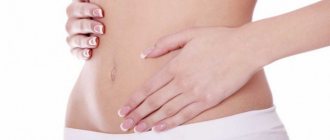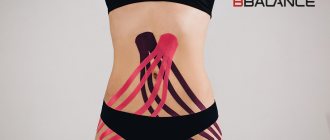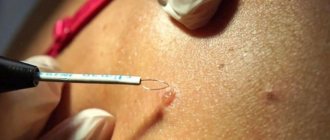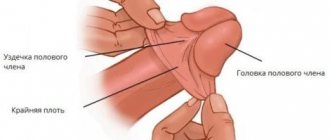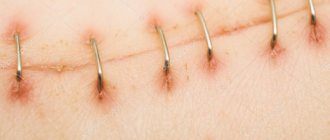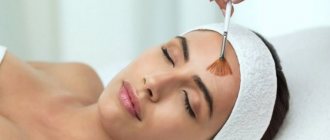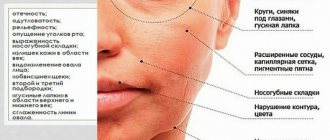12/07/2017 Category: Complications after childbirth Author: Lyudmila Morozova
A caesarean section is a delivery procedure performed surgically. Its essence lies in the fact that the doctor cuts the skin and muscle tissue, the uterus and removes the child. The healing time and aesthetic appearance of the scar in the future largely depend on the method and how well the sutures are then applied to the cut tissues.
- Healing of the incision
Photo gallery: wound healing by month
- In the maternity hospital
C-section
Caesarean section is an abdominal operation, which is accompanied by sequential dissection of layers of soft tissue. As a rule, after the fetus is removed, the soft layers of tissue are connected using suture material.
Almost always, the edges of the external incision of the abdominal anterior wall are fixed by applying a cosmetic suture after a cesarean section. After healing of this suture, an invisible and thin scar appears. In most cases, it does not cause any discomfort to the patient, either psychological or physical.
How long does a caesarean section last? As a rule, this procedure takes about 30-40 minutes. However, please note that if this is not the first such operation, the duration may be longer. Therefore, it is impossible to definitively answer the question of how long a caesarean section lasts.
What common
Despite the different techniques and materials used, the main thing among all options for restoring a damaged surface is their purpose. All types are applied for one purpose - to restore the integrity of damaged skin or internal organs.
Reference! Methods of merging skin using sutures have been known to mankind for more than 4000 years. Moreover, the first material that was used for these purposes was natural silk, as well as threads from several types of plants.
Varieties of external seams and cuts
Regardless of location, size, and other factors, the dissection of the outer tissue may be transverse or longitudinal. A longitudinal section is also often called a vertical section. In medicine, it is called a “corporal caesarean section”. Such an incision is made along the entire surface of the abdominal wall, starting from the navel and ending with the pubis.
This type of operation is used only in emergency cases when the patient or fetus requires emergency care. In such a situation, due to the high risk of muscle tissue divergence during exercise, their integrity is restored with a simple, rather than cosmetic, suture. However, there are other indications for corporal cesarean section, which are as follows:
- Varicose veins in the lower part of the uterus.
- Pronounced adhesions, as well as the inability to penetrate the lower segment of the uterus.
- Significant prematurity of the baby, as well as the unpreparedness of the female body for childbirth.
- Planned excision of the uterus after surgery.
- The presence of a longitudinal scar after the planned operation.
- The need to extract a living fetus from a dying or dead woman.
- Fetal pathology, such as conjoined twins, transverse position and much more.
Today, in the case of uncomplicated planned cesarean section, laparotomy is most often used, which provides the best aesthetic effect with the highest scar strength. A large transverse incision is made in an arc above the pubis. The scar that forms after this action practically merges with the fold of skin in the lower abdomen, and most often it is difficult to distinguish.
Types of sutures after cesarean section
The appearance of the future scar depends on many factors - how the incision was made, how the sutures were applied and what type, how the recovery period went. Each woman is individual and the healing process is different for everyone. Fortunately, with high-quality work by the surgeon, proper care and the absence of complications, the suture heals within a few weeks, and six months later, only a barely noticeable postpartum scar reminds of the operation, which is almost impossible to completely get rid of.
With a horizontal incision, the abdominal cavity is not opened, and the scar from a cesarean section will subsequently become almost invisible
Depending on the type of incision, the following types of sutures are distinguished:
- Horizontal seam. The optimal incision option today is horizontal. It is done during a planned operation, when the date and time of birth are set by the doctor. This type of operation is called Pfannenstiel laparotomy. A transverse incision is made along the natural fold of skin under the abdomen, just above the pubis, leaving the abdominal cavity untouched. After removing the baby from the uterine cavity, cosmetic stitches are applied, which are not noticeable after healing.
- Inner seam. It is applied to the incision of the uterine tissue. The main task in this case is to optimize the healing process, make the suture strong and reduce blood loss, speed up the healing process. The success of bearing subsequent children largely depends on this. Both hardware and manual suturing techniques are used, at the discretion of the surgeon.
- Vertical seam. It is practiced during an emergency operation, when seconds count and delay is dangerous for the life of the baby or woman in labor, for example, in case of acute fetal hypoxia or heavy bleeding in a woman during natural childbirth. In this case, the incision is made vertically from the navel to the pubis. This method is called a corporal caesarean section. Such a seam takes a long time to heal, has a clearly defined character and over time can become thicker and denser. The suture on the uterus is longitudinal and is sutured with strong synthetic self-absorbable threads. The abdominal cavity is also closed with stitches. Muscle tissue during a corporal caesarean section needs a strong tie; cosmetic sutures are inappropriate here. After healing, such a suture is not aesthetically pleasing; the scar is nodular in nature.
In some pathological cases, the doctor may decide to perform a corporal caesarean section - this means that the incision on the abdomen will run vertically from the navel to the pubic area
Cosmetic stitch after caesarean section
The type of threads and technique for suturing the resulting wound are selected depending on the characteristics of the operation, as well as in accordance with some diseases or complications that the patient has. To apply a cosmetic suture after a caesarean section, atraumatic special needles are used, as well as other instruments used in the field of plastic surgery. As a rule, these instruments do not injure the skin and subcutaneous fatty tissue of patients. The material for suturing is a thin monofilament or polyfilament and thread made of silk, lavsan or synthetic material.
Today, subcutaneous sutures are most often used, which can dissolve on their own within a few weeks after surgery. If for some reason it is not possible to apply them, then the integrity of the tissue can be restored with non-absorbable threads. In this case, the ligature is removed approximately one week after surgery. Suture removal, as a rule, coincides with the day of discharge from the hospital for patients.
Sutures after cesarean section: types
The surgical method of delivery is prescribed for certain medical indications. It happens that a woman in labor is prepared in advance for surgery, and there may be emergency situations. Depending on the reason that caused the need for surgical intervention, the tactics of the procedure and the type of incision are selected, which determines the subsequent type of suture.
Vertical
The main indication for corporal cesarean section is a direct threat to the life or health of the fetus or woman. Possible complications during pregnancy that can lead to this: acute fetal hypoxia, placental abruption, massive bleeding, critically high blood pressure.
In this case, the result of the surgical intervention is a vertical suture. It runs from the pubic area to the navel, the scar has a nodular structure and is often prone to compaction. Its appearance definitely spoils the appearance of a new mother’s belly. That is why this type of incision is not used unless absolutely necessary.
In this case, only a tattoo on a caesarean section scar can help. The decorative element will definitely divert attention from the skin defect and give the woman more confidence in herself and her body.
Horizontal
The medical name for this type of suture is Pfannenstiel laparotomy. It is carried out only in cases where the surgical intervention was planned and there are no acute conditions. The incision is made in the skin fold above the pubis. An important feature is that the abdominal cavity remains unopened.
A horizontal incision allows you to make a cosmetic suture. It is practically invisible on the skin, because it is applied using a special technique (intradermal and continuous).
Domestic
The method of placing internal sutures on the wall of the uterus varies depending on the condition of the organ. The main goal of proper suturing is to minimize healing time and reduce blood loss. This is also important because the course of future pregnancies and the type of delivery in the future depends on it.
For the corporal type of surgical intervention, a longitudinal type of stitching is used, for laparotomy - a transverse one.
How different types of fabrics are sewn:
The speed of recovery after cesarean section, the incidence of complications, as well as the features of care for the surgical area directly depend on what technology was used.
Seam features
What are the features of a cosmetic seam? This should include:
- Passes inside the skin.
- It is performed with special atraumatic needles, as well as very thin threads.
- It forms an invisible and thin scar that will not cause any discomfort to the woman.
- Almost invisible on the surface of the skin.
You can clearly see in the photo what a cosmetic seam looks like. During the application of this suture, the surrounding tissues are much less injured than in the case of using the conventional technique of suturing the layers of the skin. This method not only allows specialists to achieve maximum aesthetic results, but also significantly reduces the risks of developing all kinds of complications. In addition, such a cosmetic suture significantly speeds up the patient’s recovery. This is precisely the difference between a cosmetic seam and a regular one.
A postoperative thin scar is formed through the use of special self-absorbing threads: lavsan, silk, prolene or vicryl. Such materials can withstand heavy loads and also provide very reliable healing of postoperative wounds.
What is the difference between a regular seam and a cosmetic one?
The main difference between a cosmetic seam and a regular one is the aesthetic appearance of the first option. After applying it, it is practically invisible on the skin. However, common types often leave rough scars. This is explained by the fact that when applying a cosmetic method, the threads are “introduced” into the skin. Therefore, at the end of the procedure, a barely noticeable line remains.
When using the conventional method, a rough scar remains on the surface, which in surgery is called a “fish skeleton.” It often causes rejection on the part of patients, as most begin to feel inferior and disfigured.
The second difference is the scope. Conventional sutures are more versatile, therefore they are used for both external and abdominal operations. The cosmetic option is used only for operations on the skin.
Features of seam care
Many women who have undergone this type of operation are wondering how to treat the suture after a cesarean section, as well as how long the wound will take to heal. Provided there are no complications, superficial restoration of muscle tissue occurs within 2 weeks. The final scar is formed after 12-18 months. The duration of the recovery period will directly depend on the quality of care for the surface of the scar. That is why it is so important to know how and with what to treat the suture after a caesarean section.
Methods for correcting scars after cesarean section
A cosmetic suture after a cesarean section often does not require additional correction. Its location and special stitching technique allow a woman to wear two-piece swimsuits without embarrassment.
However, longitudinal cuts often cause self-doubt. Such problems can be solved using several methods:
If conservative treatment methods are ineffective, and you don’t want to agree to a repeat, albeit cosmetic, operation, then you can disguise the incision site with a tattoo. The suture after a cesarean section, shown in the photo, in this case will be almost invisible.
Postoperative care
While in the hospital, specialists treat the surface of the suture daily with special antiseptic solutions, and apply sterile dressings made of breathable materials on top.
For several days after surgery, the woman should also take painkillers. In order to prevent the development of infectious and inflammatory processes, broad-spectrum antibiotics are prescribed.
Physical activity should be increased gradually, preventing possible damage to the ligature.
How to care at home?
In order to ensure normal tissue scarring after discharge, a woman must follow certain rules and recommendations, which are as follows:
- Before the cesarean section suture is completely healed, it must be disinfected. To do this, you can use chlorhexidine, hydrogen peroxide or any other antiseptics, but you should still consult your doctor in advance.
- You should also wear a special bandage after a caesarean section. It limits the mobility of soft tissues. In addition, a bandage after a cesarean section will eliminate the possibility of sutures coming apart.
- Several times a day it is necessary to take air baths, while exposing the lower abdomen.
- Strong physical activity should be limited, as well as lifting heavy objects weighing more than 2 kg. You need to take your baby in your arms, pressing it to your chest. During this action, the postoperative bandage discussed above should also be worn on the stomach.
- Mechanical impacts on the wound surface should be avoided. Therefore, there is no need to scratch or rub your stomach, use hard towels, cosmetics, or wear uncomfortable types of clothing with belts and tight belts.
- Showering is allowed only after the stitches have been removed.
- It is mandatory to monitor the restoration of the muscle layer and uterus using ultrasound within the time prescribed by the doctor.
In addition to the fact that it is necessary to put a postoperative bandage on the stomach, you should also smear the scar with olive, sea buckthorn and other oils. After consulting with a specialist, you can use Contractubex or Solcoseryl to speed up the healing process.
Stitching
The edges of the wound are connected in various ways, but most often using a surgical needle and suture material. Important conditions are the absence of strong tension when comparing the edges of the wound, their sufficient blood supply and the absence of signs of infection or tissue necrosis.
Selection of suture material . The suture material is in contact with tissue for quite a long time and therefore must be strong, sterile, biocompatible, elastic, flexible and reliable in the knot. Depending on the purpose of the operation and the properties of the tissues that make up the edges of the wound, different types of threads are usually used sequentially. There are biological and synthetic suture materials. According to their structure, they are divided into monofilament, polyfilament and combined, and depending on their ability to biodestruct, into absorbable and non-absorbable [2].
Biological absorbable sutures are made from animal intestines. polyglycolic acid (Dexon) and a copolymer of lactide and glycolide (Vicryl). Such materials in human tissues are destroyed by phagocytes within 2 weeks. Coating the suture material with chromium salts delays this process and contributes to its longer preservation. Another modification of biological suture material is rapidly absorbable material. It breaks down within 4-7 days and is widely used in dermatosurgery. The disadvantage of using it is a more pronounced inflammatory reaction.
Synthetic absorbable materials, depending on the type, are hydrolyzed within 60-120 days. The use of such materials, in contrast to biological ones, usually leads to less pronounced inflammatory reactions in the subcutaneous tissue.
The advantage of absorbable sutures is that they do not need to be removed, the disadvantage is that they tend to form noticeable scars on the skin. Therefore, absorbable sutures are primarily used for sutures in the subcutaneous tissue, where they are well hidden [11, 39].
Non-absorbable suture materials (silk, nylon, and polypropylene threads) do not dissolve in tissues, induce a slight inflammatory reaction and therefore, when removed in a timely manner, leave less noticeable scars. Silk threads are often used in operations on the eyelids and lips. Nylon monofilaments are a general-purpose suture material, while polypropylene ones are characterized by high tensile strength. They are optimal for making intradermal sutures. In general, it is advisable to use absorbable suture materials inside the wound, and non-absorbable ones for suturing the skin.
Calibration of suture material is similar to calibration of injection needles: the higher the number, the smaller the diameter of the thread (Table 5.2). The diameter of the thread varies over a wide range - from 1 mm (very large, equal to the diameter of a thick fishing line) to 0.1 mm (the thinnest, equal to the diameter of a human vellus hair). For facial sutures, threads of size 4/0 or 5/0 are usually used; for particularly precision operations, 6/0 is used. Suturing wounds with a thin thread helps reduce the risk of formation of noticeable scars that are undesirable on the face. In those areas of the body where cosmetic defects are not of particular importance, you can use threads of size 2/0 or 3/0, which are easier to handle and more reliable [2, 7, 52].
Table 5.2. Typical material thickness size [2]
Surgical needles . During dermatosurgical operations, two types of needles are used - curved and straight. When using a curved needle, a clamp and a needle holder are required; for a straight needle, they are not required. However, suturing a skin wound with a straight needle is quite difficult and often dangerous, since you can accidentally damage your own fingers. Therefore, as a rule, safer and more convenient curved cutting or stabbing needles or curved round needles are used.
The cutting needles have a very sharp triangular tip that easily penetrates the skin. Such needles are optimal for suturing skin wounds.
Round-section piercing needles injure tissue much less and are used mainly in deep layers, less often on the skin, since it is more difficult to puncture with them.
Surgical needles are also divided into single- and reusable, with an open or closed eye and needles without an eye, directly turning into a thread. When applying sutures on the face and hands, thin, elastic, durable needles and threads are most often used. They are much sharper than reusable regular needles. In the Ethicon system, such needles have the prefix P or PS (plastic surgery), and in the Davis and Geck systems - the designations PR (plastic) and PRE (reconstructive surgery). For general practice, shortened FS (skin) needles can be used, but they may leave more noticeable marks on the skin [11, 44].
The principle of suturing skin wounds . During suturing of the wound on the skin, in order to accelerate the interpenetration of cellular elements and fibers, the edges of the wound are compared in such a way as to achieve close pressing of their dermal areas to each other. In the case of inverted edges (i.e., when the edges of the wound are turned inward and touch each other with epidermal areas), the wound heals much more slowly.
In most areas of the body, except the face, skin sutures are placed at a distance of 3-4 mm from the edges of the wound and 5-10 mm from each other; on the face these distances are 2-3 and 3-5 mm, respectively [50].
The correct choice of suture type optimizes the healing process and depends on many conditions: the depth, area, location, infection of the wound, as well as the age, gender of the patient, concomitant diseases, etc. [1].
A hidden subcutaneous suture reduces tension along the incision line and is also used to close dead space, preventing the formation of hematomas and the development of infection (Fig. 5.7).
First, the edges of the wound are brought together with sutures that widely cover the subcutaneous tissue. Then a continuous intradermal suture is applied. For this purpose, the dermis is stitched at certain intervals strictly parallel to the surface of the skin at the same depth. Absorbable suture material is usually used.
Knot stitch . One of the stitched edges of the wound is fixed with surgical tweezers. The needle is inserted on the same side. The edge of the skin and subcutaneous tissue is stitched. Using tweezers, fix the edge of the skin on the other side and pierce it with a needle. In this case, the needle is inserted and withdrawn along one line strictly perpendicular to the incision line so that the distance from the edges and depth of the wound does not exceed 2-3 mm (on the face). The suture thread is tightened and tied into a knot over the injection points, but not over the wound itself. Such sutures are the most reliable when closing wounds: if one thread breaks, the rest continue to hold the edges of the wound (Fig. 5.8).
A vertical “mattress” suture is an interrupted suture in which the needle is removed from the tissue on the same side on which it is inserted. In this case, the thread lies perpendicular to the edges of the wound. The next stitch is made on the other edge (Fig. 5.9). The application of such a suture allows for good comparison of the edges of the wound.
A “running” intradermal suture is performed according to an S-shaped template, when the thread remains in the same plane of the dermis on both sides of the wound (Fig. 5.10). The advantage of such yours is that. that they leave virtually no marks on the skin.
A continuous twisting suture according to Multanovsky is performed with catgut and is used for suturing retroauricular wounds in children and wounds on the scalp. In this case, each stitch is wrapped in a loop, due to which the tension of the thread is not transferred to previously applied stitches (Fig. 5.11). The application of such a suture allows one to achieve a satisfactory cosmetic result and quickly restore microcirculation at the edges of the wound [4].
When applying an intradermal continuous suture (Fig. 5.12), its length should not exceed 6 cm, which speeds up the healing process and allows the sutures to be removed after 6-8 days.
Methods of tying knots are divided into manual and using tools. A simple knot is the easiest and fastest to tie with your hands, but it quickly loses its fastening properties (Fig. 5.13). The sea knot is more durable and reliable (Fig. 5.14). To tie a knot a using a clamp, the thread attached to the needle is wrapped once or twice around the closed jaws of the clamp in a clockwise direction (Fig. 5.15, a). The clamp is brought to the free end of the thread, grabbed and pulled through the formed loop (Fig. 5.15.b. c). The third loop is wrapped around the clamp in the opposite direction and pulled in the direction opposite to the first knot, forming a square knot (Fig. 5.15. d) [50].
Connecting the edges of the wound using a stapler can be done with tangal, titanium or plastic staples. The main advantage of staples over suture thread is their high connection speed. which is especially important when closing wounds with heavy bleeding (for example, in the scalp). However, staples often leave more noticeable marks on the skin than threads, so they are not recommended for use on the face [50].
Rice. 5.15. Tying a knot using a clamp. Explanation in the text.
First, the edges of the wound (if necessary, using a clamp or tweezers) are unfolded like this. to compare internally. The center of the stapler (usually marked with an arrow on the device) is placed at the line connecting the edges of the wound. The skin is punctured with a paper clip by squeezing the handle of the stapler without pressing the instrument on the skin (Fig. 5.16). Then unclench the handle and move the stapler a few millimeters back to separate the staple from the tool. The paper clips should be 7-10 mm apart from each other. Removal of staples after healing is done using a clamp that pulls them out.
strips of synthetic adhesive material can be used to connect their edges . They help avoid the formation of rough postoperative scars and do not require preliminary anesthesia of the wound edges; they can be used after suture removal to hold the healing edges of a wound together. In order to glue the wound, first carefully connect the edges of the skin with your fingers or a clamp, then apply adhesive strips perpendicular to the edges of the wound so that there is at least 2-3 cm on each side of the wound (Fig. 5.17). The strips are glued at a distance of several millimeters from each other and left for several days.
Removing stitches . There is no precisely defined period for removing sutures. However, you can adhere to some temporary principles. For example, on the face the suture is left for 4 to 6 days, on the neck - from 6 to 10 days, on the back - from 10 to 14 days, on the anterior abdominal wall - from 7 to 10 days , on the lower and upper extremities - from 10 to 18 days [31].
If the sutures remain on the skin for 7-10 days, their removal is usually easy and does not cause much discomfort. First of all, this applies to simple sutures, when the thread is cut in the center of the healing wound. To do this, use nail scissors or a No. 11 scalpel blade, after which the threads are pulled out with a clamp towards the cut line. Removing mattress seams is a little more difficult. First, you need to grab the knot and lift it slightly so that a small space is formed between the skin and the seam. Then one stitch is cut under the knot and the entire stitch is gently pulled out, grasping the knot with a clamp or tweezers. To remove continuous sutures, the thread is cut in several places, then carefully pulled out, grasping the ends of the thread with a clamp or tweezers.
Recovery after surgery
The duration of the rehabilitation period will largely depend on the individual characteristics of the female body, the professionalism of doctors, as well as on the quality of the surgical intervention performed. Despite this, for some time, most patients after a cesarean section may experience discomfort of varying nature and intensity. Normally, the following symptoms may occur, even if you know what a cosmetic stitch after a cesarean section is and how to care for it:
- Moderate pain in the anterior abdominal wall for 3-5 weeks.
- Dense and raised scar up to two months after surgery.
- Discharge of ichor, which is a yellowish or clear liquid, with a slight admixture of blood from the wound during the first week.
- Moderate skin itching for 2 weeks after birth.
If all of the above symptoms cause severe discomfort and anxiety to the patient, you should report them to your doctor. If itching, pain, burning, and discharge do not go away within the specified time or increase, then mandatory medical assistance will be required.
Possible unpleasant complications
So, we have looked at how long it takes for a cosmetic suture to heal after a caesarean section. However, this time may be delayed if the patient experiences various types of complications. The early ones include the following:
- Inflammatory process in a wound after infection. As a rule, this is accompanied by swelling of the suture, suppuration, as well as swelling of the surrounding skin. In parallel with this, the patient’s body temperature rises, chills appear, and general health worsens.
- Divergence of the wound contour, as well as rupture of threads. In most cases, this occurs due to early removal of the threads, as well as high physical activity or injury.
- Hematomas and bleeding due to extensive damage to blood vessels or individual vascular diseases in a woman in labor.
All of the above early complications, as a rule, are diagnosed in a hospital setting or during the first days after the patient is discharged. Treatment will depend on the severity and nature of the pathology. Therapy includes the use of antibiotics, hemostatic agents, and additional suturing or dressing of the wound.
Most of the unpleasant consequences of a cesarean section appear a few months after birth. The most common late complication is the appearance of ligature fistulas, which are formed due to the reflection of the suture material by the human body, as well as infection of the thread. The symptoms will be as follows:
- Periodically appearing suppurations.
- Minor pain and redness in the scar area.
- The gradual appearance of several or one hole in the skin, in which ligature stitches can be seen.
If signs of ligature fistulas appear, you should immediately contact the clinic for surgical removal of the remaining threads, as well as for wound treatment.
As for the rarest complications, these include keloid scars and hernias, which are bulging soft tissue on the surface of the scar. Keloid scars do not pose any threat to the patient's health; they only cause cosmetic discomfort. As a rule, such scars appear only in those women who have a predisposition to severe tissue growth.
Cosmetic stitch: possible complications
A seam is the joining of fabrics by stitching (thread or staples). Nowadays, a cosmetic stitch is considered a simple procedure, which at the same time requires the expenditure of some money. There are a large number of clinics, various beauty centers and other medical institutions that work real miracles.
Types of seams
Sutures can be cosmetic or surgical. The first ones are performed for aesthetic purposes, as they remain visually invisible. The second are ordinary seams that leave marks. A surgical suture is created manually or with special devices. It can be external and internal. A cosmetic seam can only be external. The severity of the wound also determines how it will close. In simple cases, a permanent suture is immediately applied. If the wound is complex (rotting, internal injuries, etc.), the suture is applied temporarily. This is necessary in 2 cases:
- critical situations, if the wound heals urgently and for a short time;
- if you need to monitor the healing process.
In the first case, the surgical suture is tightly tightened until the operation is performed.
In the 2nd case, it is not tightened completely until the patient’s condition returns to normal. Surgical sutures are also permanent, removable and absorbable. Permanent ones are made from non-absorbable material and remain for life. Removable ones are ordinary sutures, in which the thread is pulled out for the patient after healing, but the scar with traces remains for a long time. Absorbable ones are made with a thread made of a special material that disappears on its own. In order for the cosmetic seam to turn out flawless, it is necessary to perform complex and delicate work. In this case, the skin is not pierced, and the procedure is carried out somewhat differently. A cosmetic seam is created directly in the epidermis of the skin, which ensures good healing, as rapid regeneration occurs. Possible complications
Quite rarely, patients are faced with a situation where the suture comes apart after surgery. This should not cause undue panic or fuss. The reason for this phenomenon is poor tissue survival due to low immunity or painful condition.
Sometimes the stitched area is subjected to excessive force, which causes damage to the skin junction area. In practice, cosmetic sutures sometimes come apart soon after surgery or after a long time. If the patient is still in a medical facility, you should not panic, but contact a doctor or nurse. In the 2nd case, the situation described is also not so dangerous. Usually only the epidermis layer diverges, since the sublayer tissues most often have already healed. If this happens, you should go to the nearest clinic or call an ambulance. Most often this happens in women giving birth after a cesarean section and any complications. This issue should be resolved with a clinic surgeon or plastic surgeon for a fee. After operations on the face and neck, subcutaneous hematomas are common complications. If the process worsens during the day, it is necessary to carry out a revision on the side of the complication, for which, under operating conditions, the sutures are removed, hemostasis is performed, and a cosmetic suture is again applied to the edges of the wound.
Re-suturing
In the most advanced cases, specialists are forced to completely remove the existing scar by reapplying the ligature. This will depend on how badly the muscle layers, skin and subcutaneous tissue have been damaged. Often, cosmetic stitches are replaced with regular ones.
The recovery period after another surgical intervention will be increased several times. In this case, you should pay attention to the fact that the re-formed scar will become the most convex, noticeable and rough. That is why, if any suspicious symptom occurs that indicates a violation of normal wound healing, you should seek help from the clinic, avoiding the occurrence of any serious consequences.
Regular seam
Before starting the procedure, the surgeon pays attention to a number of factors:
- Depth of the wound.
- The degree of damage to the skin.
- Place of application. Here we mean the organ on which the operation is performed, since various suture options are used for the skin and internal organs, as well as the materials used.
The most common options in all areas of surgery are the following:
- Nodular - subcutaneous and cutaneous. One of the most common options. For application, a cutting type needle is used. The seam itself is a triangle with the base directed towards the wounds. Thanks to this form, reliable fixation of surgical threads is achieved.
- Mattress. It is used when the surgeon finds it difficult to evenly compare the ends of the wound. Then the doctor applies a suture in the form of the letter “P” located in a horizontal plane. The Donatti method is also often used - a vertical mattress option. When applying it, the initial puncture is carried out at a distance of two centimeters from the edge of the damaged skin, on the opposite side the needle comes out at a similar distance. The next stitch is located at a distance of no more than 5 mm.
Scar correction
Even a well-made suture after a cesarean section will not guarantee the formation of a thin and neat scar in the future. Years later, some women complain of scars that are brightly colored, uneven in width, depressed or protruding. Fortunately, there are several correction methods, for example:
- Scrubbing and peeling using special cosmetics that can be used independently at home. They are allowed to be used only for external improvement of scars after consultation with a therapist or cosmetologist.
- Hardware polishing of the scar using abrasive attachments, which is carried out in specialized clinics. To achieve a lasting and visible result, a similar procedure should be carried out in several sessions.
- Laser resurfacing, which provides a deep effect on the scar and allows you to get rid of severe irregularities.
- Abdominoplasty, which is a surgical tightening of the abdominal muscles with the formation of new scars, but of a smaller size.
- Injections of drugs that prevent the growth of keloid scars.
- Massage. You should not expect a global effect from this procedure. However, slight improvement can be achieved. Special massage movements and creams will help enhance the softening effect and also reduce scars. The massage begins only after the stitches have completely healed, using smooth, gentle movements, lightly pressing on the scar with your fingertips. The procedure must be repeated several times every day for 5 minutes.
It is necessary to pay attention to the fact that these methods have a number of contraindications, and also do not allow a woman to completely get rid of the resulting scars.
Cost of cosmetic seam
How much does a cosmetic stitch cost after a caesarean section? As a rule, the cost will vary depending on the complexity of the operation, as well as the region and level of the clinic. Please note that in public clinics this procedure is carried out absolutely free. If we talk about paid clinics, then the cost here will be several thousand rubles.
In conclusion, it is worth noting that cosmetic stitches after caesarean section are increasingly performed not only in private clinics, but also in public ones. However, it is still worth checking with the surgeons in advance which sutures they will apply.
How to care for caesarean section stitches
A nurse cares for a postoperative suture in a medical facility, and therefore we will not consider this point in detail, but rather focus on care at home. What worries most women is the day on which sutures are removed after a caesarean section. This process occurs approximately seven days after application. However, in most cases, self-absorbable threads are used.
How long a suture heals after a cesarean section directly depends not only on the type of incision, but also on proper care.
Rules of care:
Important! Recently, an increasing number of doctors agree that the risk of adhesions is minimized if the peritoneum is not sutured.
